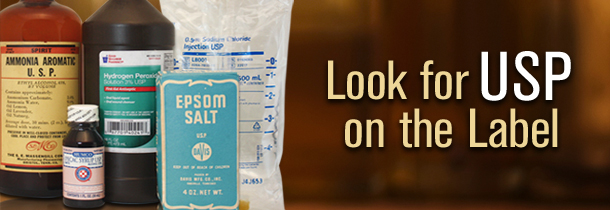
Have you ever looked at the label on a prescription or other medical product and seen the letters “USP”? This is a vestige of one of our nation’s earliest public health and safety measures, a practice that dates back to the earliest days of our democracy—well before the U.S. Food and Drug Administration (FDA) was formed.
In the early years of colonial America, medicine was practiced by apothecaries, blacksmiths, midwives, and others who provided their own versions of popular treatments. Some worked, some didn't and some were outright dangerous.
Professional doctors became more prevalent after 1765, when the country’s first medical school was established in Philadelphia. At that time doctors diagnosed disease as well as compounded and dispensed medicine. However, even though the doctors were trained in how to properly prepare medicine, there was no assurance that the medicines they made were composed of quality materials or even if they were potent.
Prominent national and medical figures such as Benjamin Franklin and John Morgan, founder of the medical college, spoke about the need for a formulary of accepted medical treatments and a national pharmacopeia to set “some Standard amongst ourselves.” Part of their goal would be realized in 1820, with the publication of the first United States Pharmacopeia.
The U.S. Pharmacopeia is a reference of uniform preparations for the most commonly used drugs—with tests to ensure their quality, potency and purity.
As the practice of pharmacy grew, medicines were increasingly made not only by pharmacists but by commercial providers. Companies like Eli Lily began to include “U.S.P.” on their product labels to indicate to pharmacists, medical practitioners and patients that the product was made in accordance with the quality standards of the United States Pharmacopeia.
These three letters convey a great deal of information to the healthcare practitioner. They let the pharmacist or doctor know that the medicine or product in the bottle meets several key quality attributes that are necessary to ensure the medicine will perform as expected. USP standards for the following quality indicators are based on laboratory testing.
- Identity–is the product what it claims to be
- Potency–is it present in the right amount
- Purity–is it free from impurities, contaminants or other unwanted ingredients
- Performance–will it dissolve and disintegrate in the body so the active ingredient can be absorbed
In 1906, President Theodore Roosevelt signed the Pure Food and Drug Act into law. The law elevated the public health role of the United States Pharmacopeia because it defined a drug as “all medicines and preparations recognized in the United States Pharmacopeia (USP) or National Formulary (NF),” and defined adulterated drugs as those referenced in the USP and NF but differing from “the standard of strength, quality, or purity” specified in the two compendia. The practice of labeling medicines with the letters “U.S.P.” or “USP” became more prevalent. In 1938, the Food, Drug and Cosmetic Act reaffirmed the role of the pharmacopeia and expanded its role to include USP standards for labeling and packaging.
Today, drugs sold in the United States are required to meet USP standards regardless of whether they include the letters “USP” on the label. As a result, some manufacturers have dropped the practice, but many still include “USP” on the label after the ingredient name. Look in your medicine cabinet, chances are you have a popular first aid antiseptic with a label that reads “Hydrogen Peroxide Topical Solution 3% USP” or something similar. Those 3 letters on the label means this product was made to USP standards.
However, the situation with dietary supplements is different.
In 1994, the Dietary Supplement Health and Education Act was passed with the intent of expanding Americans’ access to natural health products and creating a separate regulatory framework. Unlike drugs, supplement manufacturers would not need to conduct clinical trials to prove a product is effective or safe before putting it on the market. As with drugs, DSHEA requires companies to follow good manufacturing practices and recognizes the USP–NF as an “official compendia.” However, unlike drugs, compliance with USP standards is VOLUNTARY for dietary supplements.
Dietary supplement manufacturers can choose to follow USP standards and include the letters “USP” on their product labels to indicate to pharmacists, medical professionals and consumers that their products conform to USP standards—and some do, particularly for letter vitamin and mineral products like Vitamin C, Calcium and Iron. Or, dietary supplement manufacturers can create and follow their own internal private standards.
Unfortunately, the wording of DSHEA had some unintended consequences. The benefits of being able to distinguish a quality product by looking for “USP” on the label, was eclipsed by a disincentive in the form of possible regulatory enforcement consequences. DSHEA states that a dietary supplement product can be deemed misbranded if it is labeled as conforming to “USP” specifications and fails to so conform. This means dietary supplements must meet USP standards IF they include the letters “USP” on the label. Many dietary supplements companies choose not to include “USP” on their label because it may increase their risk of regulatory action from the FDA even when they do follow USP standards. This makes it difficult for pharmacists, healthcare practitioners or consumers to know if a dietary supplement product is made to conform to USP’s quality standards.
To bridge this gap and continue to provide a way to make quality visible—USP created the USP Dietary Supplement Verification Program (DSVP). The DSVP is voluntary for manufacturers. Manufacturers who participate and meet USP’s demanding criteria are given the distinctive USP Verified Mark. The USP Verified Mark on a dietary supplement label means that “what’s on the label is in the bottle” and allows consumers and healthcare professionals alike to choose supplements with confidence.


